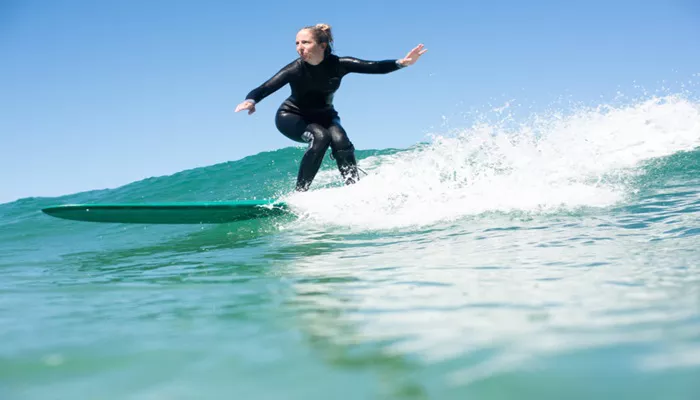Surfing is not just about finding the right waves—it’s also about timing. The time of day can significantly impact the quality of the surf, wave consistency, wind conditions, and even your overall experience in the water. Whether you’re a beginner looking for the best conditions to practice or an experienced surfer searching for optimal waves, understanding the best time to surf is essential. In this article, we will break down the factors that determine the best time to hit the waves and how different times of day affect surfing conditions.
Understanding How Time of Day Affects Surfing Conditions
Several factors contribute to the quality of waves throughout the day. These include wind patterns, tides, water temperature, and the presence of crowds. Let’s explore how these elements influence surfing at different times of the day.
1. The Role of Wind in Surfing
Wind is one of the most crucial factors that affect wave quality. Generally, there are two types of wind to consider:
Offshore Winds: These winds blow from the land toward the ocean, grooming the waves into clean, well-shaped sets that are ideal for surfing.
Onshore Winds: These winds blow from the ocean toward the land, creating choppy and unpredictable waves that are more difficult to ride.
Wind patterns typically change throughout the day, which is why certain times are better for surfing than others.
2. The Influence of Tides
Tides play a major role in wave formation. While the best tide for surfing depends on the specific beach and ocean floor, here are some general guidelines:
Incoming (Flood) Tide: Often creates better wave shape as water moves inland, filling sandbars and reefs.
High Tide: Can be good for certain breaks but may lead to waves losing power or breaking too close to shore.
Outgoing (Ebb) Tide: Can make waves faster and hollower, which is ideal for advanced surfers but may not be beginner-friendly.
Low Tide: Can expose rocks and reefs, making some surf spots dangerous.
Understanding local tide charts and how they affect your specific surf break is key to catching the best waves.
3. Water and Air Temperature Considerations
Temperature fluctuations throughout the day can also influence your surfing experience. Early morning and late evening sessions may be colder, requiring wetsuits in some locations. Midday surfing, on the other hand, offers warmer air temperatures but also exposes surfers to stronger sun rays.
4. Crowd Levels
Another important factor to consider is how busy the lineup will be. Surfing at peak hours can mean battling for waves, whereas early or late sessions often provide a more peaceful experience.
The Best Times of Day to Surf
1. Early Morning – The Golden Hour of Surfing
Why It’s Ideal:
Offshore Winds: Mornings usually bring calmer, offshore winds before afternoon onshore breezes pick up.
Fewer Crowds: Most people are still waking up, making the lineup less congested.
Crisp, Clean Waves: Cooler morning temperatures can enhance wave conditions, leading to smoother and more predictable rides.
Better Wildlife Encounters: Marine life is more active in the early hours, increasing chances of seeing dolphins and other sea creatures.
Potential Downsides:
Cold Water Temperatures: In some regions, mornings can be chilly, requiring wetsuits.
Tides May Not Be Perfect: Depending on the beach, the tide might not be at its ideal stage during early morning hours.
2. Late Morning to Midday – A Mixed Bag
Why It Can Work:
Waves Are Still Decent: If offshore winds persist, waves can remain clean.
Good for Beginners: Some locations have mellow waves during mid-morning, which is great for learning.
Warmer Water: Especially in colder regions, waiting until the sun rises can make the session more comfortable.
Challenges:
Wind Conditions Deteriorate: Midday typically brings stronger onshore winds, which can make waves choppier.
Increased Crowds: More surfers, swimmers, and beachgoers arrive, making it harder to find an open wave.
Stronger Sun Exposure: UV rays are most intense during midday, increasing the risk of sunburn.
3. Afternoon – The Windy Session
Why It’s Not Always the Best:
Onshore Winds: Afternoon winds tend to be stronger and less favorable for clean waves.
Crowded Lineups: More people hit the beach, leading to packed surf spots.
Harsh Sun Exposure: Prolonged sun exposure can cause dehydration and fatigue.
However, on certain days when offshore winds persist or if you find a sheltered surf break, afternoon sessions can still be enjoyable.
4. Evening – The Second Golden Hour
Why It’s Ideal:
Winds Calm Down: As the sun sets, winds often shift back to offshore conditions, improving wave quality.
Less Crowded:Many surfers have left, making for a more peaceful session.
Perfect Lighting: The golden hues of sunset create a breathtaking surf experience.
Cooler Temperatures: Ideal for those who want to avoid extreme heat.
Challenges:
Shorter Surf Window: With the sun setting, there’s limited time to surf.
Tide Dependent: If the evening tide is too high or too low, waves may not break well.
Factors That Influence the Best Surfing Time for You
While general guidelines can help, the best time to surf also depends on your individual preferences and skill level:
Beginners: Early morning or midday (if wind conditions are good) offers smaller, more manageable waves.
Intermediate Surfers: Mid-morning to early afternoon can be good, as waves have more shape but aren’t too powerful.
Advanced Surfers: Early morning and late evening sessions provide the best waves with minimal crowds and ideal wind conditions.
Conclution
Determining the best time of day to surf depends on a combination of wind, tides, temperature, and personal preferences. Generally, early morning and late evening are the best times for clean waves, fewer crowds, and a more enjoyable experience. However, every surf spot behaves differently, so it’s important to check local surf forecasts, tide charts, and wind conditions before heading out. By understanding these factors, you can maximize your time in the water and make every surf session an incredible experience.

